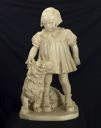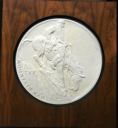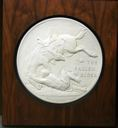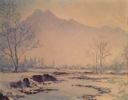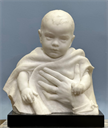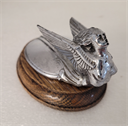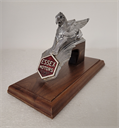Avard Tennyson Fairbanks
(Provo, Utah, 1897 - 1987, Salt Lake City, Utah)
Avard T. Fairbanks was born in 1897, in Provo, Utah. His initial instruction in art came from his father, John B. Fairbanks, who was an art teacher at Brigham Young Academy and also from his brother, J. Leo, who was a painter. Avard's first sculpture, a rabbit in clay, was done when he was 12. The sculpture won first prize at the 1909 Utah State Fair, but the judge refused to give Fairbanks the medal because he said the contest was for professionals, not for boys. His family decided Avard should go to New York to study, where his father was making private sale copies of the masterpieces at the Metropolitan Museum. The curator at the museum gave reluctant permission for Avard to make copies because he was so young (13). After seeing the quality of Fairbanks' work, the curator apologized. After an article about him appeared in the New York Herald, he was allowed to model animals at the Bronx Zoological Gardens. A scholarship to study at the Arts Students League with James Earl Fraser soon followed. During this time, Fairbanks came to know several notable sculptors who gave him advice and critiqued his work. He returned to Utah after a year and a half in New York because he wanted to study abroad. The sculpture Buffalo was made when he was 15. Although he had planned to pay for his travels by sales of Buffalo, funds came from sales resulting from attention garnered by a lion sculpture he made of butter for a creamery exhibit at the Utah State Fair. While in France in 1914, he became the youngest artist to be admitted to the French Salon: he was 17. However, his studies in Paris were cut short by the start of World War I, so he returned to Utah where he finished high school and continued modeling in clay. His first major commission was with his brother, J. Leo, to work on the statuary and friezes of the LDS Hawaii Temple. In 1918, he attended the University of Utah. Then, at the end of World War I, he was commissioned to do a war memorial called Victorious American Doughboy for the state of Idaho. This commission led to other commissions and to a teaching position at the University of Oregon. Among his other commissions were the Ninety-first Division Monument, Pioneer Family, Pony Express , and four marble busts of Abraham Lincoln. In 1925, he earned his Bachelor of Fine Arts from Yale and was awarded a Guggenheim Fellowship to study art in Rome and Florence the following year. His Mother and Child was sculpted during this period. He became a member of the faculty at the University of Michigan's Institute of Fine Arts in 1929 and while there, earned a Master of Fine Arts and also a Ph.D. in anatomical science. Fairbanks always spent time researching his intended subjects to find background information that allowed him to include accurate details. For example, Fairbanks studied historical details of Lincoln's life as well as the president's life mask in order to portray him accurately. The anatomical studies he had done in college helped him make his figures very accurate. In 1947, he returned to Salt Lake City with his family and was appointed Dean at the University of Utah where he was given the responsibility of organizing a college of Fine Arts. Considered an innovative and effective teacher, Fairbanks was, nevertheless, an "arch-conservative" artist. That conservatism resulted in departmental conflict as modernist teachers were hired but also resulted in a new generation of academically trained realist sculptors. Among Fairbanks' most successful students were Ed Fraughton, Justin Fairbanks (his son), Alice Morrey Bailey, Grant Speed, and Clark Bronson. Retiring as Dean of the College of Fine Arts in 1955, Fairbanks taught for another ten years. He continued to produce sculpture and to criticize modern abstractionism until he died at age 90 in 1987. Avard Fairbanks believed art should be simple and understandable, not only to the educated and technically trained, but also to children and the untutored. He believed art should be uplifting and represent the finer qualities of life to all men and women. He received numerous important commissions and honors throughout his career. In addition to his religious sculptures, small and large bronzes, marble carvings, medals, and relief panels, Fairbanks created hood ornaments for Chrysler Motor Co. He had been asked to design a hood ornament for the Plymouth, and had designed a mermaid, which was approved. After approval of his mermaid design, Fairbanks was asked to design an ornament for the Dodge car. The design he came up with was a ram. When management from Chrysler came to see the design, they asked Fairbanks what a ram had to do with Dodge. Fairbanks replied that when people see a ram coming down the road they'll say "dodge!" He got the commission. Fairbanks also has a serious and deeply religious side, and his sculpture Mother and Child exemplifies his belief in art as a portrayal of life's finer qualities. He lost his mother when he was fourteen-months old, and her loss consequently inspired him with great respect and honor for motherhood. Fairbanks said, "the arts are created for contemplation and edification, the expression of the highest ambitions and the spiritual hope of a people" and he applied this theory to his own art.
(Provo, Utah, 1897 - 1987, Salt Lake City, Utah)
Avard T. Fairbanks was born in 1897, in Provo, Utah. His initial instruction in art came from his father, John B. Fairbanks, who was an art teacher at Brigham Young Academy and also from his brother, J. Leo, who was a painter. Avard's first sculpture, a rabbit in clay, was done when he was 12. The sculpture won first prize at the 1909 Utah State Fair, but the judge refused to give Fairbanks the medal because he said the contest was for professionals, not for boys. His family decided Avard should go to New York to study, where his father was making private sale copies of the masterpieces at the Metropolitan Museum. The curator at the museum gave reluctant permission for Avard to make copies because he was so young (13). After seeing the quality of Fairbanks' work, the curator apologized. After an article about him appeared in the New York Herald, he was allowed to model animals at the Bronx Zoological Gardens. A scholarship to study at the Arts Students League with James Earl Fraser soon followed. During this time, Fairbanks came to know several notable sculptors who gave him advice and critiqued his work. He returned to Utah after a year and a half in New York because he wanted to study abroad. The sculpture Buffalo was made when he was 15. Although he had planned to pay for his travels by sales of Buffalo, funds came from sales resulting from attention garnered by a lion sculpture he made of butter for a creamery exhibit at the Utah State Fair. While in France in 1914, he became the youngest artist to be admitted to the French Salon: he was 17. However, his studies in Paris were cut short by the start of World War I, so he returned to Utah where he finished high school and continued modeling in clay. His first major commission was with his brother, J. Leo, to work on the statuary and friezes of the LDS Hawaii Temple. In 1918, he attended the University of Utah. Then, at the end of World War I, he was commissioned to do a war memorial called Victorious American Doughboy for the state of Idaho. This commission led to other commissions and to a teaching position at the University of Oregon. Among his other commissions were the Ninety-first Division Monument, Pioneer Family, Pony Express , and four marble busts of Abraham Lincoln. In 1925, he earned his Bachelor of Fine Arts from Yale and was awarded a Guggenheim Fellowship to study art in Rome and Florence the following year. His Mother and Child was sculpted during this period. He became a member of the faculty at the University of Michigan's Institute of Fine Arts in 1929 and while there, earned a Master of Fine Arts and also a Ph.D. in anatomical science. Fairbanks always spent time researching his intended subjects to find background information that allowed him to include accurate details. For example, Fairbanks studied historical details of Lincoln's life as well as the president's life mask in order to portray him accurately. The anatomical studies he had done in college helped him make his figures very accurate. In 1947, he returned to Salt Lake City with his family and was appointed Dean at the University of Utah where he was given the responsibility of organizing a college of Fine Arts. Considered an innovative and effective teacher, Fairbanks was, nevertheless, an "arch-conservative" artist. That conservatism resulted in departmental conflict as modernist teachers were hired but also resulted in a new generation of academically trained realist sculptors. Among Fairbanks' most successful students were Ed Fraughton, Justin Fairbanks (his son), Alice Morrey Bailey, Grant Speed, and Clark Bronson. Retiring as Dean of the College of Fine Arts in 1955, Fairbanks taught for another ten years. He continued to produce sculpture and to criticize modern abstractionism until he died at age 90 in 1987. Avard Fairbanks believed art should be simple and understandable, not only to the educated and technically trained, but also to children and the untutored. He believed art should be uplifting and represent the finer qualities of life to all men and women. He received numerous important commissions and honors throughout his career. In addition to his religious sculptures, small and large bronzes, marble carvings, medals, and relief panels, Fairbanks created hood ornaments for Chrysler Motor Co. He had been asked to design a hood ornament for the Plymouth, and had designed a mermaid, which was approved. After approval of his mermaid design, Fairbanks was asked to design an ornament for the Dodge car. The design he came up with was a ram. When management from Chrysler came to see the design, they asked Fairbanks what a ram had to do with Dodge. Fairbanks replied that when people see a ram coming down the road they'll say "dodge!" He got the commission. Fairbanks also has a serious and deeply religious side, and his sculpture Mother and Child exemplifies his belief in art as a portrayal of life's finer qualities. He lost his mother when he was fourteen-months old, and her loss consequently inspired him with great respect and honor for motherhood. Fairbanks said, "the arts are created for contemplation and edification, the expression of the highest ambitions and the spiritual hope of a people" and he applied this theory to his own art.
Artist Objects
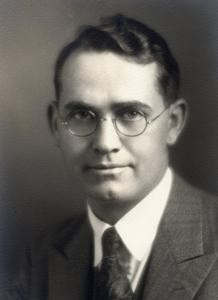
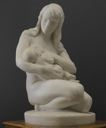
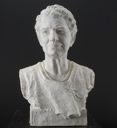
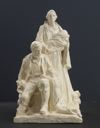

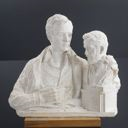


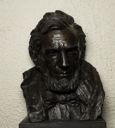


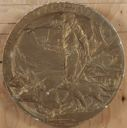

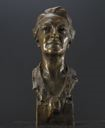


![Image of The Mountain Man [right hand cast of a pair of bas reliefs]](/media/Thumbnails/2005.001_2009.999/2007.033.png)
![Image of The Indian [left hand cast of a pair of bas reliefs]](/media/Thumbnails/2005.001_2009.999/2007.034.png)


